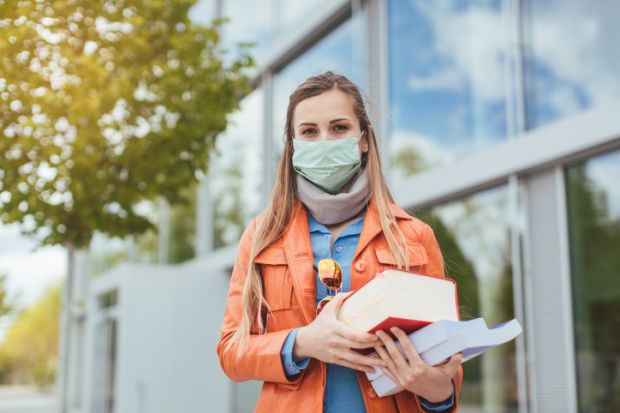As we start the new academic year, many countries still find themselves in a precarious public health position, largely thanks to the increasingly dominant, and highly transmissible, Delta variant of Covid-19.
In the UK, new daily cases currently remain high, and while hospitalisations are drastically reduced thanks to a high vaccination uptake, they are still gradually increasing. In the US, where Delta is currently surging, new daily cases and deaths are rising among younger adults. In Australia, Victoria, New South Wales and Canberra are in the middle of a lockdown, with students subject to a stay at home order. And, across Europe, a number of countries are keeping or introducing various mitigations to minimise outbreaks.
As such, universities will need to introduce mitigations to guard against a repeat of last year, when the opening up of campuses prompted a wave of Covid outbreaks. A recent article of ours in the British Medical Journal, as well as an Independent Sage report, has made a number of suggestions. In essence, these build on the Swiss Cheese model of pandemic defence, consisting of multiple measures at the individual and institutional level.
At this point in time, vaccination alone is insufficient. A recent modelling study suggests that at least 90 per cent of university staff and students would need to be fully vaccinated for “normal” operations to be justifiably resumed. The only way to reach coverage of 90 per cent or higher would be through a campus-wide vaccination mandate for faculty, staff, and students – but many universities in the UK and US have refused to institute mandates.
And while the overall student body is diverse, a large fraction of it is young adults, among whom full vaccination coverage is relatively low: currently approximately 50 per cent in both England and the US. Rates specifically among university students might be higher, but based on that level of coverage, modelling suggests that frequent testing and “aggressive distancing and other non-pharmaceutical prevention policies” might be necessary.
Of particular concern is the lack of clarity and consistency around certain policies, especially on masks and ventilation. In the US, where campuses have already reopened, many universities have had to scramble to reintroduce mask mandates in response to rising rates and new Centers for Disease Control guidance advising masks even for fully vaccinated individuals in areas of high transmission. Although it varies by state, more and more universities are requiring masking as local transmissions grow.
In the UK, the guidance across the four nations varies regarding higher education as much as it does regarding public transport or shops. For example, the UK government’s official guidance misleadingly states that “face coverings are no longer advised for students, staff and visitors either in teaching rooms or in communal areas”. In Wales, current guidance states that masks are required in “public areas”, but this does not include classrooms or lecture theatres. In Scotland, masks are required in all “communal areas”, including lecture theatres and seminar rooms.
Hence, it is unsurprising that Independent Sage recently found that UK universities vary in the clarity, framing and strength of their messages on masks. A recent Times Higher Education survey found that although most were encouraging or requesting face coverings, the details varied, even within nations.
Many university staff are concerned about the risk of Covid-19 on campus and are unhappy with current measures. Public mask-wearing is most effective at reducing spread of the virus when everyone does it. However, although England’s chief medical officer, Chris Whitty, recently recommended continued mask-wearing in certain settings, it is no longer officially required and there are already signs that it is becoming denormalised. That is particularly true among young adults, yet while students may be anxious to return to campus, the risk to them of contracting long Covid is not negligible.
As such, if masks are to be an effective way to protect both staff and students, a clear and consistent requirement for their use across universities is needed – not least to avoid confusion among staff around whether, when or how to advise or enforce compliance.
An additional concern is ventilation. The UK government has often asserted that “common sense” is the best route out of the pandemic. However, in reality, adequate protections and mitigations rely on scientific advice based on “uncommon science” – Covid-19 is a novel disease and our knowledge of it is evolving.
Although scientists now know the significance of airborne transmission, a recent UK survey found that washing hands and sanitising surfaces is popularly regarded as a more effective way of curbing Covid’s spread than wearing face coverings and opening windows. As such, clear guidance on ventilation, consistent across universities, is also crucial. And this should include information on which kinds of buildings may have relatively poor ventilation, so that people can make informed decisions about where to go and how to conduct themselves when they are there.
In addition to encouraging and facilitating vaccination, such measures will avoid the scenario already common in the US of having to revert to online-only education again. This time next year, many university students in many countries will hopefully have a much more “normal” academic experience. But we are not there yet.
Simon Williams is senior lecturer in people and organisation at the Swansea University. Gavin Yamey is professor of the practice of global health at Duke University.
Register to continue
Why register?
- Registration is free and only takes a moment
- Once registered, you can read 3 articles a month
- Sign up for our newsletter
Subscribe
Or subscribe for unlimited access to:
- Unlimited access to news, views, insights & reviews
- Digital editions
- Digital access to THE’s university and college rankings analysis
Already registered or a current subscriber? Login








